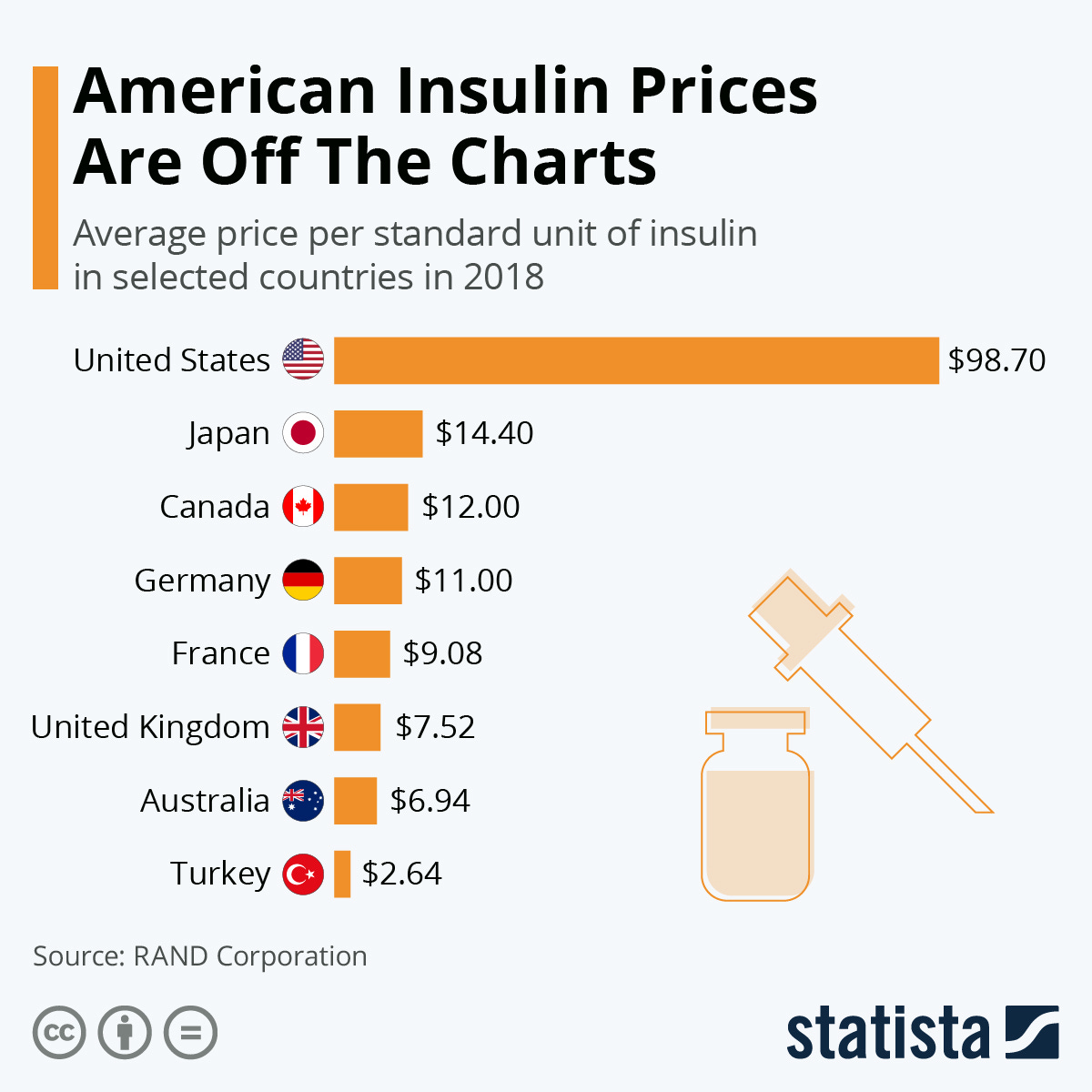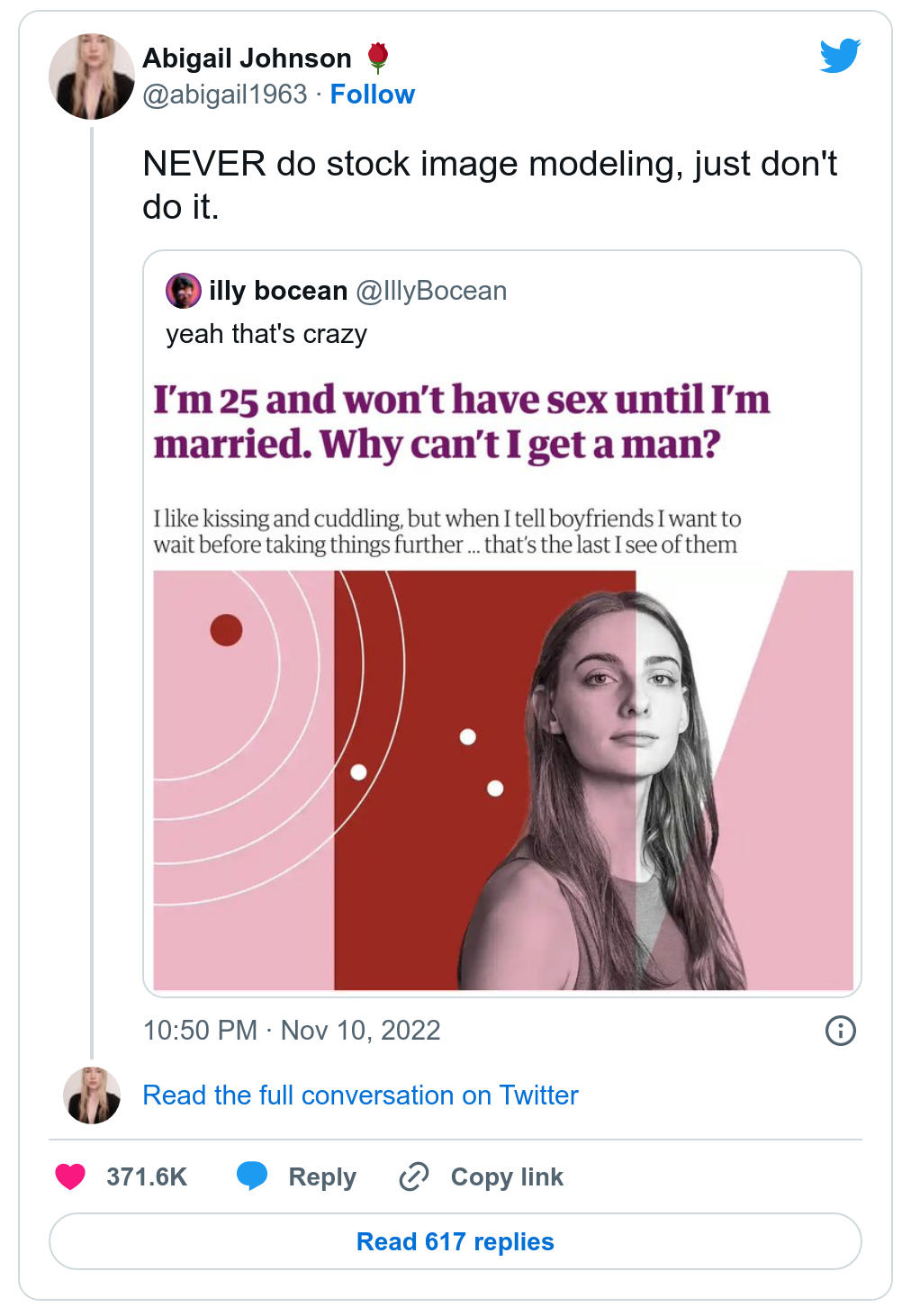This week…
Abigail Johnson tweeted that one should never do stock image modelling. Her post quoted another tweet that showed a screen-capture of an article on The Guardian titled, “I’m 25 and won’t have sex until I’m married. Why can’t I get a man?” The image accompanying that article is presumable a stock photo modelled by Johnson.
A commenter replied that it could be worse, far worse, sharing a 2013 article, from the same sex advice column in The Guardian no less, titled, “I fantasise about group sex with old, obese men,” with a stock image of another model.
That model happens to be Samatha Ovens, who was featured in a different column in The Guardian a couple of weeks later, with the same stock image, in an article called, “I do NOT like sex with old, obese men: the perils of being a stock-shot model.” I shared this article in response to the commenter.
As someone who used to work in print, I can share with you a little bit about some of the best-case practices where stock image usage is concerned. First, you will want a representative image, that is, not just of the topic, but the audience you write for. For example, at a Malaysian publication, my editorial team would always use Asian faces (although sometimes we used ethnically ambiguous stock models from South America, for example, if none of the Asian stock images represented the topic well). Second, there is an ethical consideration as well. When articles involve delicate topics such as sex, certain health conditions, or violence, typically, we would look for images that do not feature human models, or we use stock illustrations instead. When we would use images with human models, their faces would be covered. For example, they could have their face in their hands, or their back to the camera, or it’s a silhouette. I guess these days, one could render an AI-generated image as well.
Anyway, I took screenshots of these tweets instead of linking you directly to them due to the NSFW nature of the content. But I thought the thread is an appropriate representation of the shambolic situation unfolding with Twitter, where falsehood and confusion make a humourous embarrassment out of the app.
And now, a selection of top stories on my radar, a few personal recommendations, and the chart of the week.
Pharmaceutical giant Eli Lilly & Co apologises after fake Twitter account says insulin is free as Elon Musk rolls back verification
Brianna Morris-Grant for ABC News:
A fake account posing as pharmaceutical company Eli Lilly & Co and registered under the Twitter Blue system tweeted: “We are excited to announce insulin is free now.”
The tweet prompted Eli Lilly’s stock to drop sharply by percentage points, according to Investor’s Business Daily.
“We apologise to those who have been served a misleading message from a fake Lilly account,” the company said, reiterating the name of its Twitter handle.
Eli Lilly had previously faced scrutiny for its insulin prices, following reports that revealed some Americans were stockpiling the drug because they could not afford more.
What does verification actually mean?
Ryan Broderick on Garbage Day:
I don’t think you should have to be popular or famous to earn the privilege of not having your identity stolen and I don’t think you should have to pay for it either. Because it shouldn’t be a privilege! It should be the bare minimum that a social platform can offer because if they can’t then what makes them any different than 4chan? Twitter is being eaten by its own obsession with fame and status and, honestly, right now, it’s the most fun it’s ever been.
Elon Musk’s Twitter is harming users with disabilities ($)
Megan McCluskey for Time:
Unique in its ability to amplify marginalized voices, Twitter has become a vital tool for building and sustaining community among vulnerable populations, says [Ethan Zuckerman, an associate professor of public policy, communication, and information at the University of Massachusetts Amherst].
“For years, people have been finding community on social networks when they have difficulty finding community in the physical world,” he says. “That could be people who are in small minorities in the communities where they’re living or it could be people for whom it’s difficult to access the physical world.”
Just over a week after taking control of Twitter, Musk gutted the company’s accessibility team. That means the work those employees were doing to make the platform accessible for as many people as possible has stopped. For example: adding image descriptions to tweets for people who are visually impaired and updating Twitter’s sounds to help make them pleasing to people with sensory sensitivities.
What I read, listen, and watch…
I’m reading an interview with researcher Carl Miller by Anton Protsiuk for The Fix on the risk Wikipedia faces as a target of information warfare.
I’m watching this latest gem from Theramin Trees.
Reviews, opinion pieces and other stray links:
Two fathers one egg by David Warmflash for NEO.LIFE.
Canva launches text-to-image AI feature by James Vincent for The Verge.
Man repatriates 19 antiquities after reading Guardian article by Dalya Alberge for The Guardian.
Chart of the week
From a 2020 piece by Niall McCarthy for Statista:

And one more thing
The ‘Red Wave’1 that wasn’t.

I like this idea, actually. If political punditry is ‘sportified,’ we get a good idea of pundits’ track records—their at-bats, their last home run, which pitcher they do well against, etc. It is complementary to how news organisations should always disclose their pundits’ affiliations, and will thus help audiences make informed assessments of the views they are listening to.
Sidenote: It reminds me of the story of how the marketing for the ⅓-pound burger failed in the US.2 Apparently, Americans thought the quarter-pounder is bigger because the ‘4’ in ¼, being larger than the ‘3’ in ⅓, misled them.
It is quite jarring to watch North American sports on television, and find out just how much statistics are used to measure almost every single action in every single sport—and then learn about stories like this. Does the average American sports spectator understand the stats the commentators babble on about, or are they just pretending?
Anyway, the burger marketing people should’ve called it a .333 burger competing against a .250 burger, and, yes to the lower third with pundits’ BA.
The Starting Block is a weekly collection of notes on science and society with an emphasis on data, democracy, and disinformation. Read the archives. Find me on Twitter, Instagram and LinkedIn. Send questions, corrections, and suggestions to tinacarmillia@substack.com.
Editorial. “The Guardian View on the US Midterm Results: The Red Wave That Wasn’t.” The Guardian, The Guardian, 9 Nov. 2022, www.theguardian.com/commentisfree/2022/nov/09/the-guardian-view-on-the-us-midterm-results-the-red-wave-that-wasnt. Accessed 12 Nov. 2022.
Palma, Bethania. “Did Third-of-a-Pound Burger Fail Because People Didn’t Understand Fractions?” Snopes, Snopes.com, 17 June 2022, www.snopes.com/news/2022/06/17/third-pound-burger-fractions/. Accessed 12 Nov. 2022.







The pundits batting average is a damn good idea tbh 😂